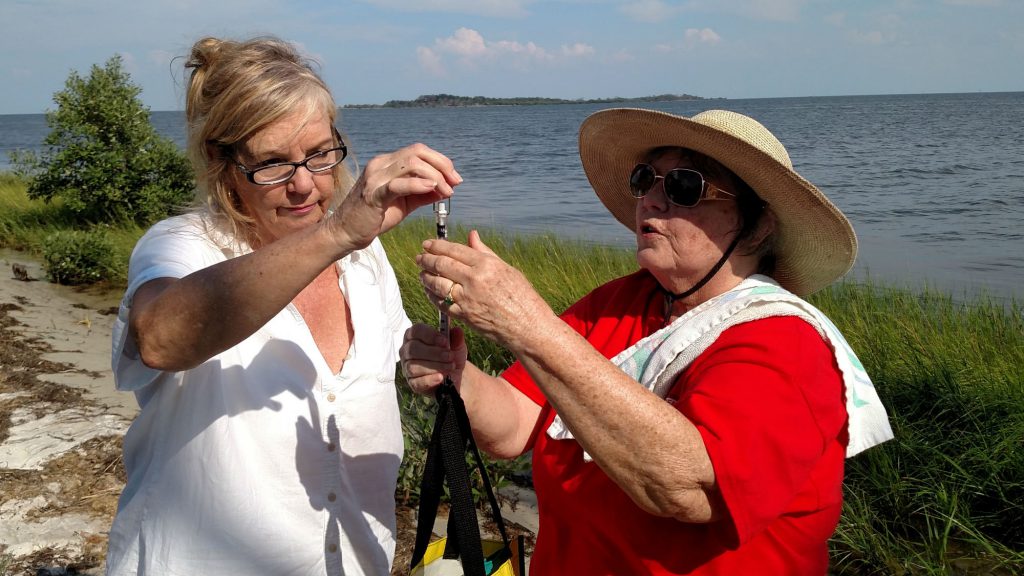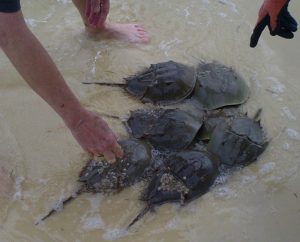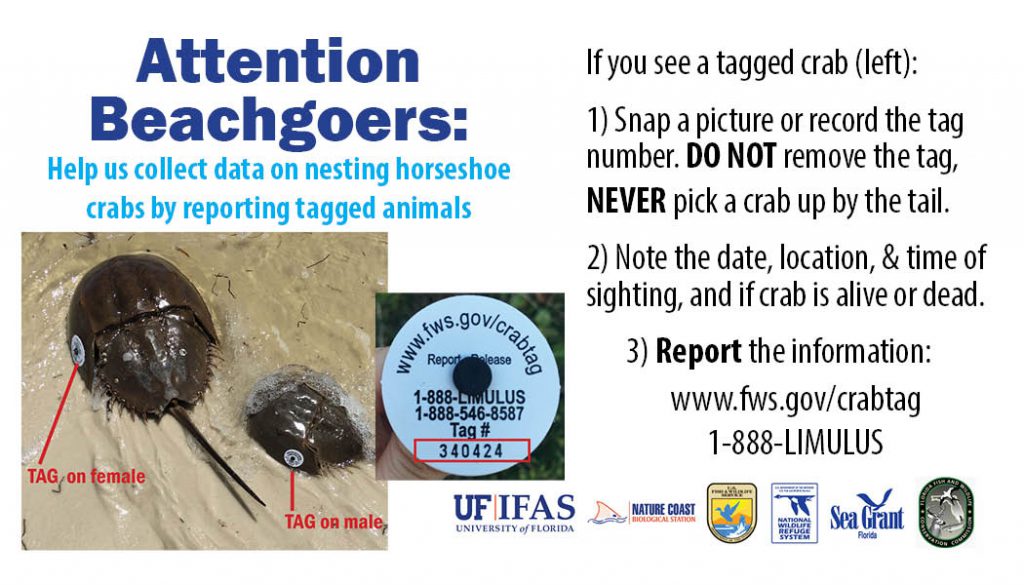These and other questions are the focus of Limulus watch, a citizen scientist initiative whose goal is to identify, tag and record nesting horseshoe crab population numbers to better manage these important marine animals. Resighting is one method of tracking crab migration, populations and health. Fall 2017 – Spring 2018 saw a 6.3 percent resighting rate. Several resights were credited to the general public, being reported by citizens at large according to Dr. Jane Brockmann, UF Emeritus Professor. “Resighting pins are provided by U.S, Fish and Wildlife Service when qualifying tag information is reported” stated Brockmann.

Nature Coast Master Gardeners were tagged for special acomplishments.
The Migrating Crab Award – for surveying the most sites in one season, was presented to Linda Redditt and Linda ‘Digger’ Headley.
The Golden Awl Award – presented to Deborah Goad in recognition of the most tagged crabs.
Goad also bagged the Terminal Molt Award for most volunteer hours during the season. Goad (John) and George, provided leadership to the Seahorse Key sites. They made surveying a pleasant experience for novice participants Carol ‘Crab Whisperer’ Wood and myself. I admit feeling hesitant to handle crabs, with all the flailing legs. However, I soon found my niche. Three hours of measuring and tagging passed quickly.
“Seventeen volunteers were trained in 2016, 79 in 2017 and 113 unique participants in 2018” reported Savannah Berry, Ph.D. University of Florida Regional Specialized Agent – Coastal Ecosystems, during the season finale at Nature Coast Biological Station, Cedar Key.
A Stroll in the Surf.
On full and new moons in fall and spring, horseshoe crab congregate at high tide to breed. They prefer sandy sites in bays or inlets, protected from

waves. Crab watch participants count and record horseshoe crab numbers at specific sites. Mating pair as well as single “satellite” males are included in the count. In addition, surveyors scout for previously tagged “resight” crabs. Crabs are collected, weighed and data recorded. Measurement is taken at the shell’s widest point. Shell damage, missing limbs, tail injury and approximate age are documented. Identification tag number are assigned. A small hole is made through the shell and the barbed tag installed. Typically, identification tags are placed on the left side of the shell. That’s the crabs left, when tail is pointed toward you. Finally, tagged crab are released at shoreline.
Florida’s horseshoe crab serve an important ecological function. Eggs are a food source for migratory birds and shore birds. Likewise, sea turtles, fish and true crabs feed on eggs and horseshoe larva.
Medical and Economic Impacts
Along the northeast United States, horseshoe crab are harvested for used in human medicine. Blood is extracted from the heart of wild caught horseshoe crab. Most horseshoe crab survive the procedure and are released alive. Horseshoe crab have blue, copper-based blood that contains a special clotting agent, Limulus Amebocyte Lysate (LAL). LAL clots when exposed to endotoxins, chemical poisons released by certain infectious bacteria. The LAL test is extremely sensitive. As a result, it is the standard for testing all injectables since 1987. The U.S. Food and Drug Administration, requires LAL tests on all human and animal injectable and intravenous drugs. Likewise, on medical devices used to deliver these injectable drugs, and all prosthetic devices (such as hip replacements or heart valves).

What you can do.
Horseshoe crab don’t bite or sting, However sharp spines rim the lower shell edge. Therefore, handle from the shell’s upper portion. Gently lift crab from the sand by placing your hands around the front edges of the shell, with tail facing away from you. Never pick up a crab by its tail. This may permanently damage the joint at its base or break the tail. The tail helps to steer and right the crab if turned upside down.
Black congratulated participants for launching these original Florida sites. Foundational sites were seven areas on Cedar Key Island (Levy County), New Smyrna Beach (Volusia) and Fort Desoto (Pinellas County). Two sites at Bald Point State Park (Franklin County), Shired Island (Dixie County) and Hagans Cove (Taylor County) were added in 2017. Spring of 2018 brought in an additional three beaches at Fort Clinch State Park (Nassau County). Plans are to expand to forty coastal sites in 2019. Contact Tiffany Black, 352-543-1080 or email tiffany.black@myfwc.com to participate or for more information.
All extension and services are open to all without regard to race, color, age, sex, religion, national origin or handicap.
 0
0
